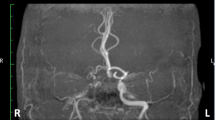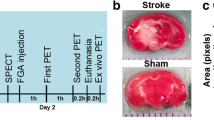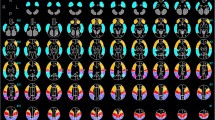Abstract
Luxury perfusion characterized by depressed metabolism compared with CBF might be changed by decreasing cerebral perfusion pressure during the sitting position. A 77-yr-old man with subacute cerebral infarction was studied with brain X-ray computed tomography (CT), raise-up test with99mTc-d,1-hexamethylpropyleneamine oxime (HMPAO) brain single photon emission tomography (SPECT) and positron emission tomography (PET). Brain X-ray CT revealed a low-density area in the left middle cerebral artery (MCA) anterior area. Raise-up99mTc-HMPAO brain SPECT revealed decreased uptake in the left MCA anterior area in the sitting position and subsequent supine99mTc-HMPAO brain SPECT revealed hot accumulation there. PET study in the supine position demonstrated some differences between CBF and the cerebral metabolic rate for oxygen in the left MCA anterior area, indicating luxury perfusion. CBF in the area of luxury perfusion might be decreased during the sitting or standing position and increased during the supine position by dysautoregulation of the cerebral vessels in the luxury perfusion during the subacute infarct.
Similar content being viewed by others
References
Lassen NA. The luxury-perfusion syndrome and its possible relation to acute metabolic acidosis localised within the brain.Lancet 19: 1113–1115, 1966.
Ackerman RH, Correia JA, Alpert NM, Baron JC, Gouliamos A, Grotta JC, et al. Positron imaging in ischemic stroke disease using compounds labeled with oxygen 15; initial results of clinicophysiologic correlations.Arch Neurol 38: 537–543, 1981.
Lenzi GL, Frackowiak RST, Jones T. Cerebral oxygen metabolism and blood flow in human cerebral ischemic infarction.J Cereb Blood Flow Metab 2: 321–335, 1982.
Olsen TS, Larsen B, Skriver EB, Heming M, Enevoldsen E, Lassen NA. Focal cerebral hyperemia in acute stroke; incidence, pathophysiology and clinical significance.Stroke 12: 598–607, 1981.
Hayashida K, Nishiooeda Y, Hirose Y, Ishida Y, Nishimura T. Maladaption of vascular response in frontal area of patients with orthostatic hypotension.J Nucl Med 37: 1–4, 1996.
Frackowiak RSJ, Lenzi GL, Jones T, Heather JD. Quantitative measurement of regional cerebral blood flow and oxygen metabolism in man using15O and positron emission tomography: Theory, procedure, and normal values.J Comput Assist Tomogr 4: 727–736, 1980.
Lammertsma AA, Jones T, Frackowiak RSJ, Lenzi GL. A theoretical study of the steady-state model for measuring regional cerebral blood flow and oxygen utilization using oxygen-15.J Comput Assist Tomogr 5: 544–550, 1981.
Lassen NA. Autoregulation of cerebral blood flow.Circulation Research 15 (suppl. I): 201–204, 1964.
Author information
Authors and Affiliations
Rights and permissions
About this article
Cite this article
Cho, IH., Hayashida, K., Kume, N. et al. Visualization of pressure-dependent luxury perfusion in a patient with subacute cerebral infarction. Ann Nucl Med 12, 217–220 (1998). https://doi.org/10.1007/BF03164849
Received:
Accepted:
Issue Date:
DOI: https://doi.org/10.1007/BF03164849




